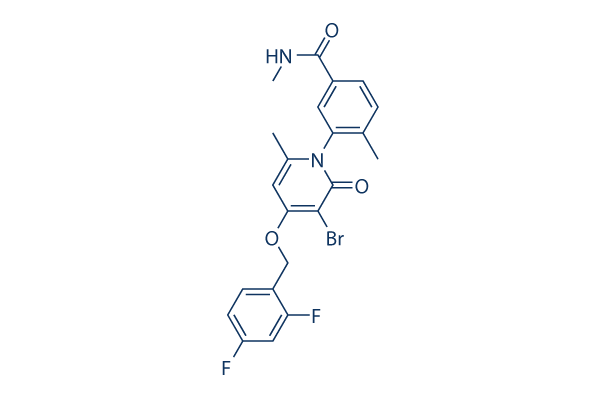| Cas No.: | 586379-66-0 |
| Chemical Name: | PH 797804,PH797804 |
| Synonyms: | PH 797804,PH797804 |
| SMILES: | O=C(C1=CC=C(C(N2C(C)=CC(OCC3=CC=C(C=C3F)F)=C(C2=O)Br)=C1)C)NC |
| Formula: | C22H19BrF2N2O3 |
| M.Wt: | 477.3 |
| Sotrage: | 2 years -20°C Powder, 2 weeks 4°C in DMSO, 6 months -80°C in DMSO |
| Description: | PH-797804 is a novel pyridinone inhibitor of p38α with IC50 of 26 nM; 4-fold more selective versus p38β and does not inhibit JNK2. |
| In Vivo: | Orally dosing of PH-797804 effectively inhibits acute inflammatory responses induced by systemically administered endotoxin in both rat and cynomolgus monkeys. PH-797804 treatment for 10 days demonstrates robust anti-inflammatory activity in chronic disease models, significantly reducing both joint inflammation and associated bone loss in streptococcal cell wall-induced arthritis in rats and mouse collagen-induced arthritis. Dose-response analysis resulted in ED50 values of 0.07 mg/kg and 0.095 mg/kg in rat and cynomolgus monkeys, respectively. PH-797804 inhibits LPS-induced TNF-α, IL-6, and MK-2 activity in a dose- and concentration-dependent manner in a human endotoxin challenge model [1]. |
| In Vitro: | PH-797804 blocks LPS-induced TNF-α production and p38 kinase activity in the human monocytic U937 cell line, with comparable IC50 of 5.9 nM and 1.1 nM. PH-797804 has no inhibitory effect on either the JNK pathway (c-Jun phosphorylation) or ERK pathway (ERK phosphorylation) in U937 cells at concentrations up to 1 μM. PH-797804 inhibits RANKL- and M-CSF-induced osteoclast formation in a concentration-dependent manner, with IC50 of 3 nM in primary rat bone marrow cells [1]. IC50 values for PH-797804 against the following targets have been determined to be greater than 200 μM (unless specified): CDK2, ERK2, IKK1, IKK2, IKKi, MAPKAP2, MAPKAP3, MKK7 (>100 μM), MNK, MSK (>164 μM), PRAK, RSK2, and TBK1, which means the activity of PH-797804 is specific [2]. |

 DC Chemicals' products qualify for U.S. tariff exemptions. We guarantee no price increases due to customs duties and maintain stable supply, continuing to deliver reliable research solutions to our American clients.
DC Chemicals' products qualify for U.S. tariff exemptions. We guarantee no price increases due to customs duties and maintain stable supply, continuing to deliver reliable research solutions to our American clients.





















